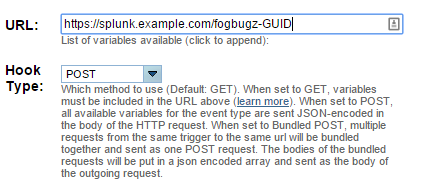Splunk: Wrap a webhook for delivery to an HTTP Event collector
It all started with FogBugz WebHooks. I wanted to bring them into Splunk and using the Splunk HTTP Event Collector seems like a good fit.
There were a few problems with sending the raw data to a Splunk HTTP event collector:
- There was no way of configuring the Authorization header in the FogBugz webhook
- The Splunk event collector expects the event data to be in an
eventfield
FogBugz WebHook
{"eventtype":"CaseEdited", "casenumber":"123", ...}
Required Splunk HTTP Event Collector Event
{"event": {"eventtype":"CaseEdited", "casenumber":"123", ...} }
I already have Nginx running on a reverse proxy (with SSL) sitting in front of my search head. What I want to do is take the FogBugz webhook data, wrap it into a Splunk event, add the Auth header and post to the Splunk Forwarder running on the same box. Like this:

1. Splunk Forwarder
First, setup the HTTP input. I have created an app that I push out to the Nginx server with my deployment server
[http]
disabled = 0
[http://fogbugz-webhook]
disabled = 0
index = main
indexes = main
sourcetype = fogbugz
token = SOME-GUID
When you restart the forwarder, this will start the HTTP Event Collector listening on port 8088.
2. Nginx
Next up you need to modify the Nginx config file to add the location /fogbugz-GUID. I put a GUID in the location just to make it unguessable.
location /fogbugz-GUID {
proxy_pass https://localhost:8088/services/collector;
proxy_read_timeout 90;
proxy_connect_timeout 90;
proxy_redirect off;
proxy_set_header Host $host;
proxy_set_header X-Real-IP $remote_addr;
proxy_set_header X-Forwarded-For $proxy_add_x_forwarded_for;
# wrap the fogbugz webhook body for splunk
proxy_set_body "{\"event\":$request_body}";
# Add the Splunk token into the Authorization header
proxy_set_header Authorization "Splunk SOME-GUID";
}
service nginx reloadwill enabled the location- Nginx-Proxy.conf is a gist of my anonymised nginx config file that is running in production
3. FogBugz
Create the webhook in FogBugz to point to your shiny new location.

Notes
- There was another issue of opening up the firewall and maintaining SSL certificates which was solved by my solution
- I can’t get the event time to line up with
eventtimein the webhook data. If anyone can help, please holler